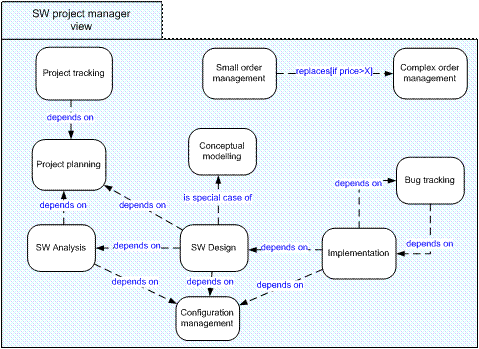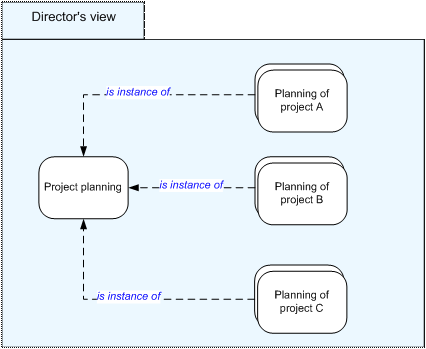The Process Modeling City
(POEM /
BPMN tutorials, posters, examples)
BPMN = Business Process Modeling Notation
POEM = Process Oriented Enterprise Modelling methodology. For describing business processes, roles, aretefacts and their instances.

|
POEM -> POEM packages -> Process overview diagramBasicsProcess Overview is the high perspective view on the processes in organizations and relationships among them. It shows, for example, which process replaces, depends on another process or conforms to standard or directive. For quality manager, it is important to have the overview on all processes, which are performed in the organization. This diagram answers basic questions such “Which processes are we performing to satisfy our business goals?”, “What are relations, dependencies between processes?”. The diagramming technique is primarily intended for managers, business analysts, quality managers and other employees. It can also be used, for example, as a part of ISO 9001 compliant quality manual, the section which describes all key processes in an organization.
Description, concepts and relationsThe structure of processes is represented by Process map diagram. The aim of this diagram is to show the overview of the processes in particular organization and static relations among them. Process details (e.g. workflow, inputs, outputs) are hidden. Basic concepts represented in this diagram are process (P X ), process instances (PI X ) and relation. Relations are directed. Process can be manual or automated, see extra (i) mark in upper right corner of Figure below . Figure . Basic concepts in Process map diagram The diagram doesn't show sequence of process execution. The following types of relations between processes were defined, where P X and P Y represent pair of related processes [ Figure below ]:
Relations “ depends on”, “replaces if”, “conforms to” and “ is version of” are stereotypes of UML and BPMN association. As mentioned, package can represent whole diagram, or just part of it. Example, shown on left side of Figure below , represents only those processes and relations on a class abstract level, which are important to Software Project Manager. Right part of Figure below shows model of process and its instances. Figure : Examples of Process map diagram syntaxSyntax of Process map diagram is shown in table below. Definitions of some non-terminal symbols (e.g. <ManualProcess>, <InformatizedProcess>) are not presented in details, because they are not essential for understanding.
|






